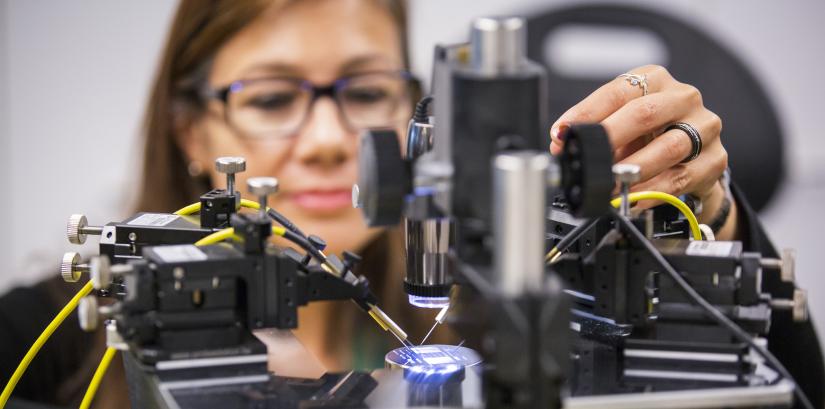A novel carbon-based biosensor developed at UTS is set to drive new innovations in brain-controlled robotics.

Professor Francesca Iacopi is an expert in nano-electronics and materials. Photo: Andy Roberts
Developed by Professor Francesca Iacopi and her team in the UTS Faculty of Engineering and IT, the biosensor adheres to the skin of the face and head in order to detect electrical signals being sent by the brain. These signals can then be translated into commands to control autonomous robotic systems.
A study of the biosensor has been published in the Journal of Neural Engineering this month
The sensor is made of epitaxial graphene – essentially multiple layers of very thin, very strong carbon – grown directly onto a silicon-carbide-on-silicon substrate. The result is a highly scalable novel sensing technology that overcomes three major challenges of graphene-based biosensing: corrosion, durability and skin contact resistance.
“We’ve been able to combine the best of graphene, which is very biocompatible and very conductive, with the best of silicon technology, which makes our biosensor very resilient and robust to use,” says Professor Iacopi.
Graphene is a nanomaterial used frequently in the development of biosensors. However, to date, many of these products have been developed as a single-use applications and are prone to delamination as a result of coming into contact with sweat and other forms of moisture on the skin.
By contrast, the UTS biosensor can be used for prolonged periods and re-used multiple times, even in highly saline environments – an unprecedented result.
Further, the sensor has been shown to dramatically reduce what’s known as skin contact resistance, where non-optimal contact between the sensor and skin impedes the detection of electrical signals from the brain.
“With our sensor, the contact resistance improves when the sensor sits on the skin,” Professor Iacopi says. “Over time, we were able to achieve a reduction of more than 75 per cent of the initial contact resistance."
“This means the electric signals being sent by the brain can be reliably collected and then significantly amplified, and that the sensors can also be used reliably in harsh conditions, thereby enhancing their potential for use in brain-machine interfaces.”
The research forms part of a larger collaboration to investigate how brainwaves can be used to command and control autonomous vehicles. The work is a partnership between Professor Iacopi, who is internationally acclaimed for her work in nanotechnology and electronic materials, and UTS Distinguished Professor Chin-Teng Lin, a leading researcher in brain-computer interfaces. It is funded by $1.2 million from the Defence Innovation Hub.
If successful, the research will produce miniaturised, customised graphene-based sensors that have the potential for application in defence environments and beyond.

